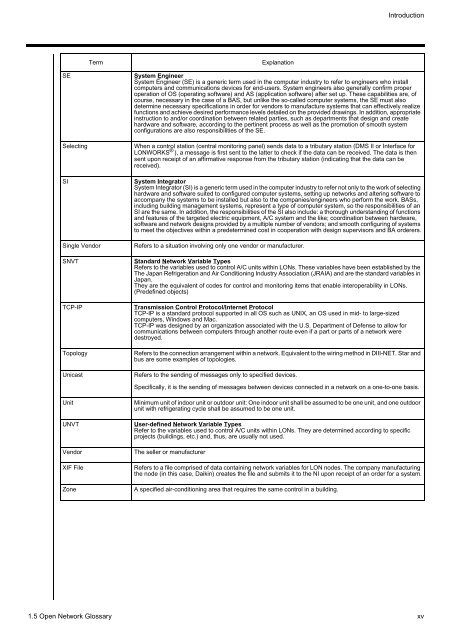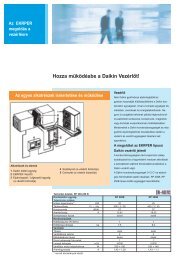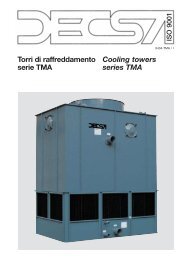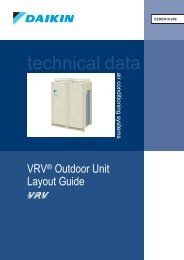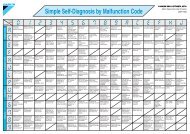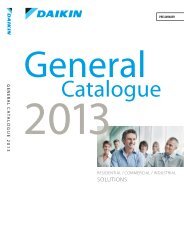1. D-BACS - Daikin
1. D-BACS - Daikin
1. D-BACS - Daikin
You also want an ePaper? Increase the reach of your titles
YUMPU automatically turns print PDFs into web optimized ePapers that Google loves.
Term Explanation<br />
Introduction<br />
SE System Engineer<br />
System Engineer (SE) is a generic term used in the computer industry to refer to engineers who install<br />
computers and communications devices for end-users. System engineers also generally confirm proper<br />
operation of OS (operating software) and AS (application software) after set up. These capabilities are, of<br />
course, necessary in the case of a BAS, but unlike the so-called computer systems, the SE must also<br />
determine necessary specifications in order for vendors to manufacture systems that can effectively realize<br />
functions and achieve desired performance levels detailed on the provided drawings. In addition, appropriate<br />
instruction to and/or coordination between related parties, such as departments that design and create<br />
hardware and software, according to the pertinent process as well as the promotion of smooth system<br />
configurations are also responsibilities of the SE.<br />
Selecting When a control station (central monitoring panel) sends data to a tributary station (DMS II or Interface for<br />
LONWORKS ® ), a message is first sent to the latter to check if the data can be received. The data is then<br />
sent upon receipt of an affirmative response from the tributary station (indicating that the data can be<br />
received).<br />
SI System Integrator<br />
System Integrator (SI) is a generic term used in the computer industry to refer not only to the work of selecting<br />
hardware and software suited to configured computer systems, setting up networks and altering software to<br />
accompany the systems to be installed but also to the companies/engineers who perform the work. BASs,<br />
including building management systems, represent a type of computer system, so the responsibilities of an<br />
SI are the same. In addition, the responsibilities of the SI also include: a thorough understanding of functions<br />
and features of the targeted electric equipment, A/C system and the like; coordination between hardware,<br />
software and network designs provided by a multiple number of vendors; and smooth configuring of systems<br />
to meet the objectives within a predetermined cost in cooperation with design supervisors and BA orderers.<br />
Single Vendor Refers to a situation involving only one vendor or manufacturer.<br />
SNVT Standard Network Variable Types<br />
Refers to the variables used to control A/C units within LONs. These variables have been established by the<br />
The Japan Refrigeration and Air Conditioning Industry Association (JRAIA) and are the standard variables in<br />
Japan.<br />
They are the equivalent of codes for control and monitoring items that enable interoperability in LONs.<br />
(Predefined objects)<br />
TCP-IP Transmission Control Protocol/Internet Protocol<br />
TCP-IP is a standard protocol supported in all OS such as UNIX, an OS used in mid- to large-sized<br />
computers, Windows and Mac.<br />
TCP-IP was designed by an organization associated with the U.S. Department of Defense to allow for<br />
communications between computers through another route even if a part or parts of a network were<br />
destroyed.<br />
Topology Refers to the connection arrangement within a network. Equivalent to the wiring method in DIII-NET. Star and<br />
bus are some examples of topologies.<br />
Unicast Refers to the sending of messages only to specified devices.<br />
Specifically, it is the sending of messages between devices connected in a network on a one-to-one basis.<br />
Unit Minimum unit of indoor unit or outdoor unit: One indoor unit shall be assumed to be one unit, and one outdoor<br />
unit with refrigerating cycle shall be assumed to be one unit.<br />
UNVT User-defined Network Variable Types<br />
Refer to the variables used to control A/C units within LONs. They are determined according to specific<br />
projects (buildings, etc.) and, thus, are usually not used.<br />
Vendor The seller or manufacturer<br />
XIF File Refers to a file comprised of data containing network variables for LON nodes. The company manufacturing<br />
the node (in this case, <strong>Daikin</strong>) creates the file and submits it to the NI upon receipt of an order for a system.<br />
Zone A specified air-conditioning area that requires the same control in a building.<br />
<strong>1.</strong>5 Open Network Glossary xv


